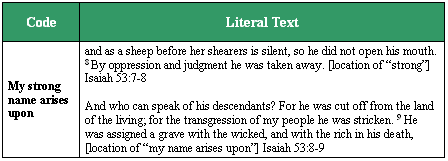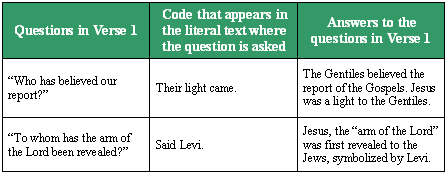| |
Uncovering More of the Tapestry
Bible codes are like individual threads in a tapestry. The code described in the previous article surfaces every twentieth letter within the literal text of Isaiah 52 and 53. Yet each code finding is just one thread — which is never enough to give us the whole picture. For that, we must study the literal text itself. Even so, if the tapestry is divine, it would not be surprising if the individual threads closely connected with the picture presented by the literal text. And perhaps, some of these threads might shed a bit of light on highly symbolic words in the Biblical text, or on who "he" is or "they" are.
In this article, we will look at numerous different ways that the newly extended 40-letter-long "Gushing" code interweaves with the literal text where it is situated. While any one or two or three of these linkages could easily be chance, it is much harder to dismiss a collection of numerous linkages that quickly and naturally suggested themselves from the intersection of the content of the code itself and of the literal text itself. Coincidences come in single events, or perhaps a pairing of unusual events, but they rarely are like a clump of grapes, or a complex thicket of interlocking circumstances, such as those which are necessary for life to exist and thrive on planet earth.
The first "coincidence" is the Hebrew word where the letter difference exists between the different Hebrew texts used by code search software. It is  , meaning "for our transgressions." What is a copying error but one type of "transgression?" To a Jewish scribe whose charge was to copy the text without making any errors, making such an error would truly be a transgression, not just an error. Many of these scribes believed that God had encoded the Bible and that a copying error could have a major effect on such codes. , meaning "for our transgressions." What is a copying error but one type of "transgression?" To a Jewish scribe whose charge was to copy the text without making any errors, making such an error would truly be a transgression, not just an error. Many of these scribes believed that God had encoded the Bible and that a copying error could have a major effect on such codes.
Code skeptics have been quick to cite the fact that there are letter differences between the various ancient Hebrew texts that are used by code search programs as proof that codes do not exist. Instead, the reality is that human beings are just scratching the surface as far as investigating the phenomenon of Bible codes. If God encoded the Bible, it is also possible that God limited copying errors to ones that would still produce intentional codes — in at least one version if not in both versions.
How Well Do They Mesh?
The 40-letter-long Gushing code runs backwards from Isaiah 53:12 to Isaiah 52:13. As it does so, its different phrases appear in portions of the literal text that have different emphases. It seems to us that there is a one-to-one correspondence of the segments of the 40-letter code and the portions of the text. So we present below the ways in which we see this correspondence existing, and we ask readers to judge for themselves as to whether we are seeing rightly or not.
The four segments that we see in both the code and the literal text are:
Part I: The Servant's Rewards from Above
Part II: Why He Deserved Those Rewards:
"The Lord has Laid on Him the Iniquity of Us All" (v. 6b)
Part III: How the Jews Viewed the Servant
Part IV: Bringing Salvation to the Gentiles
In the following review, each word or phrase from the code is shown on the left, with the corresponding literal text in which that word or phrase is found on the right. In several instances, we split up single verses in the literal text — because the last letter of the code shown was in one phrase in the verse, while the first letter of the next word in the code was in a different phrase in the verse.
Part I: The Servant's Rewards from Above

The word "poured" in the literal text is right between the second and third letters of the Hebrew word for "gushing" in the code. [The English of the Hebrew word where a letter of the code is located is in bold.]
The word for "gushing" ( , or sh-KAHK) is translated as "to run about, bustle, be lively" or "to be hungry or thirsty." It becomes gushing when used to refer to the action of water, in which case it is also translated as "rushing" and "overflowing." , or sh-KAHK) is translated as "to run about, bustle, be lively" or "to be hungry or thirsty." It becomes gushing when used to refer to the action of water, in which case it is also translated as "rushing" and "overflowing."
The prophets spoke of God often as "the fountain of living waters." Jesus linked Himself to this aspect of God when He told the Samaritan woman at Jacob's well, "If you knew the gift of God and who it is that asks you for a drink, you would have asked him and he would have given you living water . . . whoever drinks the water I give him will never thirst again." (John 4:10, 13)
In John 7:38, Jesus is quoted as saying, "Whoever believes in me, as the Scripture has said, streams of living water will flow from within him." By this he meant the Holy Spirit, whom those who believed in him were later to receive. Which Scripture He was referring to is not clear, but there are several in Isaiah that refer to "the pouring out" of the Holy Spirit, including Isaiah 32:14-15:
The fortress will be abandoned, the noisy city will be deserted; citadel and watchtower will become a wasteland forever, and delight of donkeys, a pasture for flocks, till the Spirit is poured upon us from on high, and the desert becomes a fertile field, and the fertile field seems like a forest.
In Ezekiel 43:1-2, the prophet tells of his encounter with someone he describes as "the glory of the God of Israel." Ezekiel states that the sound of this person's voice was "like the roar of rushing waters." In the transfiguration accounts in the Gospels, presented in the first article of this series, the voice of God coming from the cloud is so awesome that Peter, James and John are terrified.
John had a similar vision of "someone like a son of man" that he described in Revelation 1:14-15: "His head and hair were white like wool, as white as snow, and his eyes were like blazing fire. His feet were like bronze glowing in a furnace, and his voice was like the sound of rushing waters." The context makes it clear that this person was Jesus.

The text of Isaiah 53:10-12 is seen by many as a prophecy of the resurrection of Jesus and His return to heaven after his death on the cross for the atonement of the sins of mankind. The code, "gushing from above," could imply that Jesus came "from above." Both the code and the literal verses echo Philippians 2:5-11:
Your attitude should be the same as that of Christ Jesus: Who, being in very nature God, did not consider equality with God something to be grasped, but made himself nothing, taking the very nature of a servant, being made in human likeness. And being found in appearance as a man, he humbled himself and became obedient to death — even death on a cross! Therefore God exalted him to the highest place and gave him the name that is above every name, that at the name of Jesus every knee should bow, in heaven and on earth and under the earth, and every tongue confess that Jesus Christ is Lord, to the glory of God the Father.
Part II: Why He Deserved Those Rewards
"The Lord has Laid on Him the Iniquity of Us All" (v. 6b)
We present the next two tables in reverse order of the appearance of the Hebrew words shown in the code — so that the English translation of the code will make sense. The actual order of the Hebrew words (shown in English equivalents) is [Yeshua] [name] [strong], whereas it is shown below in this order: [strong] [name] [Yeshua].


The theme of verse 10 is that God would lay a very severe hand on the suffering servant, by (1) crushing him; (2) causing him to suffer; and (3) making his life a guilt offering. The theme of a severe hand is repeated in the part of the code crossing this verse: "My strong name arises upon Yeshua."
In Phillipians 2:9-10, reference is made to "the name that is above every name" that God will give to Jesus so that "at the name of Jesus every knee should bow, in heaven and on earth and under the earth." The "strong name" mentioned in the code is a likely candidate for that name.
Suppose all that we knew about Yeshua from the Old Testament was what was stated in the phrases where the encoded word Yeshua appears (shown enclosed in the lower right box immediately above). From this terse excerpt, we would learn that: (1) Yeshua was non-violent and honest; (2) Yeshua suffered and died as an atonement for the sins of others; and (3) he would live again.

Who do the clouds represent, and why were they rejoicing? This was discussed at length at the end of the first article. People (and angels?) in heaven rejoiced over the salvation made possible by the flogging and crucifixion of Jesus.

In Hebrew, the same word is used for hill as for mountain. The hill could be Golgotha, where Jesus was crucified, since the literal passage readily suggests what occurred at Calvary. Alternatively, the mountain could be Mount Olivet (the Mount of Olives), where Jesus ascended into heaven (See Acts 1:12). This latter possibility would tie in well with "my clouds rejoiced" from the first part of the code.
Part III: How the Jews Viewed the Servant

Verse one poses two questions, and the letters of the code found in these two questions belong to two different sentences in the code, one of which refers to the Jews (Levi being the representative) and the other to the Gentiles ("Their light came"). Curiously, the encoded sentences got it right in terms of answers to the two questions posed in verse one, as the following table shows.

That the Jews would not believe in Jesus was prophesied in Isaiah 53:1, as recounted in John 12:37-38:
Even after Jesus had done all these miraculous signs in their presence, they still would not believe in him. This was to fulfill the word of Isaiah the prophet: "Lord, who has believed our message and to whom has the arm of the Lord been revealed?"
Jesus was revealed to the Jews and verses two and three of the literal text accurately describes how most Jews viewed him:
- He grew up like a tender shoot, like a root out of dry ground.
- "He had no beauty or majesty to attract us to him."
- There was "nothing in his appearance that we should desire him."
- "He was despised and rejected by men."
- "He was a man of sorrows."
- He was "familiar with suffering."
Part IV: Bringing Salvation to the Gentiles

Jesus was a light to the Gentiles [referred to in Isaiah 52:15 as "many nations"], as stated in John 12:46: "I have come into the world as a light, so that no one who believes in me should stay in darkness." That light was shed, as the code states, is reiterated in the literal text: "what they were not told, they will see." (Isaiah 52:15)
Note that a word again implying water or blood ("sprinkle") appears in the literal text, just as the phrase "poured out" from Isaiah 53:12 and the word "gushing" from the code do.

That "God is in it" is emphasized by the yud of God in the code corresponding with the yud of yud-heh-vav-heh (Yahweh) in the literal text. How was God in it, as the code states? Acts 2:4 states, "But God raised him from the dead, freeing him from the agony of death." So the code meshes with verse 13, where it states that "he will be raised and lifted up and highly exalted."
God was also "in it" in terms of the flogging of Jesus that was inferred in the prophecy within verse 14. This is also echoed in Isaiah 53:10, referred to above, where it states that God would lay a very severe hand on the suffering servant.
How Well Do They Fit Together?
Things important to God are typically the focus of many witnesses. The transfiguration was a key event, and so all four Gospel writers refer to it. [Unlike the longer accounts in Matthew, Mark and Luke, John only briefly alludes to it in John 1:14: "The Word became flesh and made his dwelling among us. We have seen his glory, the glory of the One and Only, who came from the Father, full of grace and truth."]
Peter was sensitive to criticisms that he and other disciples had been "clever" in "crafting" accounts of their experiences with Jesus of Nazareth. So he also attested to his direct witness of the transfiguration:
We did not follow cleverly invented stories when we told you about the power and coming of our Lord Jesus Christ, but we were eyewitnesses of his majesty. For he received honor and glory from God the Father when the voice came to him from the Majestic Glory, saying, "This is my Son, whom I love; with him I am well pleased." We ourselves heard this voice that came from heaven when we were with him on the sacred mountain. 2 Peter 1:16-18
The 40-letter code in Isaiah 52-53 bears the earmarks of yet another witness to the transfiguration of Jesus. Or does it? What we have engaged in is, at least in part, an inherently a subjective exercise. We invite your comments regarding how well (or not so well) you believe the 40-letter code, the literal passage in Isaiah 52-53, and the New Testament accounts of the transfiguration (and the crucifixion and resurrection) of Jesus mesh together. Perhaps you have seen some more parallels that we haven't. Perhaps you think we are stretching things. E-mail your comments to us at info@biblecodedigest.com.
We would not be surprised if some day many will look back and recognize that efforts to relate the content of Bible codes to the literal text where they appear will emerge as a fruitful method of studying the Bible — as long as we quickly admit that the reliability of the content of codes will always be inferior to that of the literal text.
Related Articles
New 40-Letter Code Dramatically Links Isaiah 53 with Gospel Accounts of the Transfiguration of Christ
Skeptics' Criticisms Lead to Discovery of Much Longer Code
|
Enjoy finding your own Bible codes.
Bible code search software is available in our online store.
Subscribe Free! Sign Up Today!
Become a member of the non-profit Isaac Newton Bible Code Research Society.
Not only will you be part of the world's leading organization researching and publicizing Bible and Torah codes, but you will receive Bible Code Digest absolutely free, including . . .
- Latest Bible Code News
- Easy-to-Understand Bible Code Feature Articles
- Exciting Inside Information from Leading Code Researchers
- Details of Great New Discoveries
- Summaries of the Latest Battles Between Code Proponents and Skeptics
Stay current on Bible code news. Be first to hear about all of the latest Bible code discoveries.
Sign up to receive Bible Code Digest today.
|
|





 |









